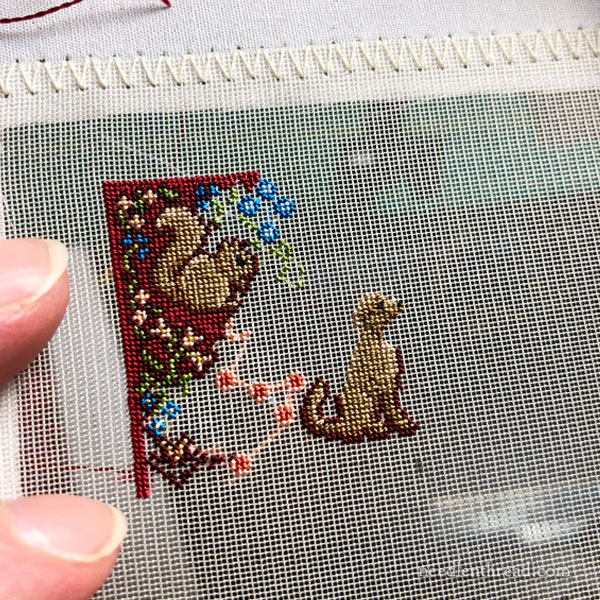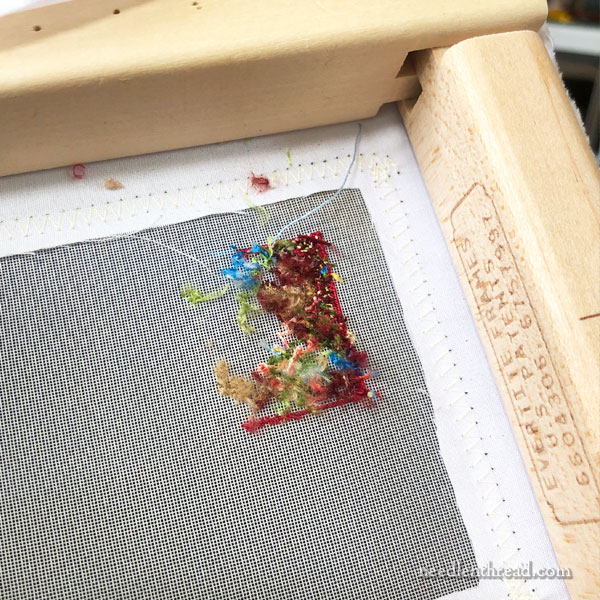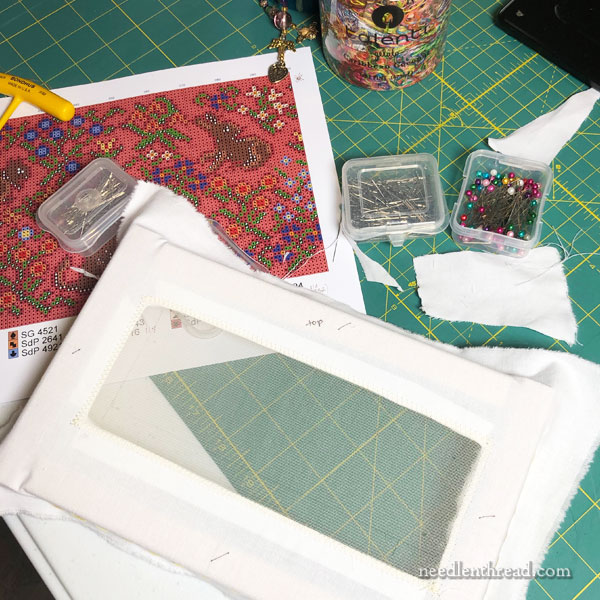You know when you have an idea in your head that won’t go away until you at least try to do it?
Well, ever since I made the little tapestry smalls in my Thousand Flowers collection, I’ve had this idea to make a tiny treasure box using an extended version of the tapestry smalls – a version that incorporates all the animals and lots of flowers.
And I set about measuring and “engineering” the box mentally not too long after finishing and launching A Thousand Flowers. I charted the main piece I’d need. And not too long ago, I set up the project and starting some stitching on it.

A Thousand Flowers is a petit point design worked on silk gauze, using silk threads. As you might tell by looking at the general design, it’s inspired by millefleur tapestries – those gorgeous tapestries of the Middle Ages and beyond that feature backgrounds be-speckled in thousands of flowers – and particularly the Lady and the Unicorn series housed at the Cluny museum in France.
The tiny trinket box I envisioned (and I’m still adjusting my vision for it a little bit!) is round. So to construct the box, I need a long piece that covers the circumference of the box I want to build.
So I charted away, calculating for 40 count silk gauze that would give me a piece the length and height I needed.
One thing I didn’t really take into consideration is the variance between the size of the animals on my individual original tapestry smalls, and their size when they are put together into one tapestry.
So on my new chart for this box piece, the squirrels are hilariously large when compared to the dog and the cat.
The killer squirrel in the upper corner looks like it might have malevolent intentions towards that happy hound.
I’m not actually going to change anything about the animal sizes. It isn’t unusual to see, in the tapestries of old, animals that don’t measure up against each other, size-wise. In the embroidery world (on the renowned boxes of the 17th century, for example), it isn’t unusual to see animals that are completely disproportionate to their surroundings and their associates.
So it’s not something I’m going to sweat. I think when the whole thing is finished, it’ll be just fine.

However, at the rate I’m going, it’s going to take a long while to get the whole thing finished.
There was a little miscalculation at the very beginning of the project. Something went amuck in the floral area around the squirrel. I had the idea that I could go ahead and stitch the dog in, then wing it with the flowers around the squirrel and the dog until I got things back “on count.”
As you can see, this eventually resulted in having to pick the whole thing out.
At times like these, I appreciate very small, sharp scissors and very good tweezers! (These are wonderful tweezers for this kind of work.)
Now, you might be sympathizing with me for having to carefully – ever-so-carefully – snip and tweeze out all those stitches in order to salvage the silk gauze. But I didn’t mind doing it, once I put my mind to it. Since I knew I had to do it, I settled myself down under some good light, put on some nice music, got my tools, and slowly and carefully, in a very relaxed and calm way, snipped away at it.
An hour and a half later, I was still snipping away at it.
Perhaps I wasn’t as calm and resigned at that point.
And perhaps the moment I slipped my scissors straight through the silk gauze, I lost all pretense of calm resignation.
Perhaps.

But realizing that I would never (and I mean never) go back to it if I didn’t set up a new piece of gauze right then and there – and therefore I would never see my mini trinket box idea through – I set about preparing a new piece of gauze right away.
That was a totally wasted day. It took me hours to stitch in the dog (plus all the flowers around him, which you can’t see yet in the first photo), then hours to pick it all out. I was just to the last corner bit by the squirrel when the scissors slipped right in and lopped the squirrel’s head clean off.
Maybe it was a sign? Maybe I should adjust the size of the killer squirrels.
Maybe I shouldn’t make the box?
Naaaaaah!
It was certainly a sign that I was rushing and getting impatient. I probably should’ve just saved myself the time and gone straight for the new gauze. But … lesson learned!
This is not a project I’m in any hurry to stitch.
Thank goodness.
A Thousand Flowers
If you’re interested in miniature work on silk gauze and you love millefleur tapestries as much as I do, you might like my Thousand Flowers tapestry smalls!
Here’s a little information on designing and stitching the original tapestry smalls. You can read more about them here and see how I originally finished some of them. You can also see how I finished them in a pocket watch setting here.
And you can find my instructional e-book, deer supplement, and a full kit (with gauze, silk threads, and needles) available in my shop here. There are only a few lingering kits left – they’re a great way to have all the materials on hand for creating your own tapestry smalls!







An enthusiastic YES to killer squirrels!
Animal humor like this has a long tradition in medieval illuminations, such as bunnies riding on snails, jousting with knights.
Hello Mary,
what is “petit point” is that cross stitch? I could not find it in the definitions.
Also will you have the chart available?
thank you
Hi, Agnes – petit point is really just tiny needlepoint – so, essentially, tent stitch (or half cross stitches). The charts for A Thousand Flowers are available as an e-book in my shop: https://shop.needlenthread.com/product/a-thousand-flowers-e-book I’d recommend tackling one of the smalls before committing to something this size. If the box works out the way I want it to, I’ll most likely eventually make the chart and instructions available.
“It isn’t unusual to see, in the tapestries of old, animals that don’t measure up against each other, size-wise…. it isn’t unusual to see animals that are completely disproportionate to their surroundings and their associates.”
Yes! See “The Vision of St. Eustace” by Pisanello. (See also the description — too long to paste here! — of the very similar fresco in the ancient chapel described in Elizabeth Goudge’s “Pilgrim’s Inn.”)
Yes, the little stag on the shelf behind him makes me chuckle. It occurs to me that sometimes, the size discrepancy might be to give a sense of depth or distance in an otherwise relatively “flat” painting (perhaps the flatness coming off the icon-like paintings of earlier eras). I’ll have to look up the Elizabeth Goudge reference… Thanks, Sarah!
Mary, Mary, Mary! You’re making me feel like a total slacker today. I’m trying to motivate myself to get back to a simple outline on a tea towel, while you’re making teensy weensy squirrels and puppies. You are amazing.
Hello Mary,
I am in such awe of your work with these miniatures. I have your kit with the 40 count gauze and I made three attempts to work the pattern. I also ruined my first attempt with my scissors. I used a piece of solid fabric on my lap underneath it and my stitching lamp with the magnifier to make it as easy as possible to see the fabric. My second attempt was equally unsuccessful because I stretched the fabric trying to remove stitches. At that point I ordered more gauze, but 30 count this time. I put it aside again because I was finding it too difficult to see in order to count accurately. I stitch on 40 count linen without a problem and was totally unprepared for how challenging it would be for me to stitch on silk gauze of the same count. I haven’t taken it out again and I’m so disappointed. I love the patterns and I want to make them. The stitches are simple and I have never had a problem with this type of counted pattern before, but the scale of the silk gauze has me totally defeated. I don’t know what to try next. Any suggestions?
Hi, Alessandra – The solid fabric on your lap – is it dark? If you put a dark background behind the gauze, it’s much easier to see. I find high count silk gauze easier to work on than high count linen, because the holes are relatively large compared to the fabric. I know you can definitely switch to linen – there’s no reason why you can’t stitch these on 40 count linen (or 32 count linen). If you use 32 count linen, you might have to use two strands to get full coverage. That’s something you can test to see what works best. Give it a try! And let me know how you get on!
Oh, Mary, this is going to be just STUNNING. Already sooooo gorgeous, makes my mouth
“water”. :D. I liked the little ornament thingies, but this, oh, this… no words. But then I am a sucker for miniature things. I can’t wait to see your little box. So glad you didn’t get discouraged and scrap the idea. I think it’s going to be one of your “best ever stuffs!” (Don’t mind my English/grammer, I get goofy when I’m all jazzed!). Love, love it. Did I say, I love it? Yup, love it…
Thanks, Carol! I’m still working out some of the “engineering” parts in my head, but now that I’m stitching on a new piece of gauze, I have plenty of time to think when I’m working on it. LOL! LOTS OF TIME! I think this is going to take a while…
Dear Mary
It’s been a long time since I have commented on your website, but things have been busy with my hip replacement exercising and walking to get it working again. Thank goodness I can now walk and bend and get on my knees through determination and patience and putting up with the pain. But any way enough of feeling sorry for myself. I hope you are well and keeping safe.
I do understand how feel about ripping threads out I just did that very thing recently on the felt birds I was making for a friend I had to rip it out twice talk about frustrating. But I’m glad you have persevered and set up a new gauze to start again you will feel glad that you have done that. It looks a great project and I can’t wait to see future progress on this project. Thank you for sharing with us your new project from the Thousand Flowers series, look forward to the progress.
Regards Anita Simmance
Welcome back, Anita! I hope your new hip is cooperating and you’re achieving greater (and more pain-free) mobility with it! I imagine it’s a long slog to get things working again as they should. I hope you have pretty places to walk!
I managed to start the new silk gauze piece yesterday. I find myself double and triple counting everything, to make sure I don’t have to do that again. Your felt birds sound like a fun project!
Good to “see” you again! 🙂
Thank you, thank you, thank you and did I say thank you. It is wonderful having all these links on one page!!!! It will no doubt lead to many hours of happy stitching.
I think I might have tried to rescue the dog by appliqueing the stitched piece to the new silk gauze. An extra layer of the gauze is hardly going to make a discernible difference to the depth of the finished piece.
I love your work and envy your productivity and the diversity of projects you design and stitch. Where do you get the silk gauze you use in your miniatures?
Hi, Suzy – Different needlework shops. It really depends on the count of gauze I’m looking for and the availability for shipping. Needle in a Haystack (www.needlestack.com) carries some counts. Also, Natalia’s Fine Needleworks (google it) carries a wide variety of gauges.